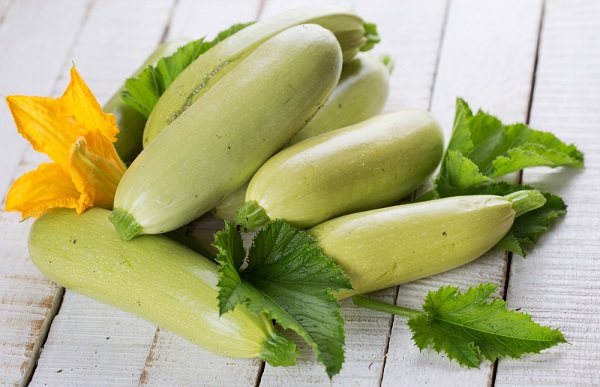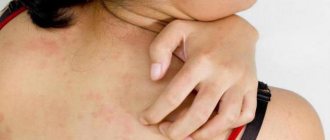This article will focus on zucchini. This vegetable, so common in southern countries, is also loved by people in northern latitudes. The food industry offers more and more new dishes from this product, right down to squash jam, not to mention caviar. If you ever wondered whether zucchini causes allergies, it means that after consuming it in any form, your health has worsened. You can have different attitudes towards this product: love it or hate it. However, allergy sufferers should be especially careful. Although this product is considered harmless, since it is given even during the first feeding to babies, there are still frequent cases of diagnosing an allergy to zucchini in adults and children.
Products for starting complementary feeding
Food allergies are extremely common and are experienced not only by adults, but also by infants, most often when complementary foods are introduced. If a woman is breastfeeding, the allergen may be contained in her milk. Pediatricians suggest using vegetables, cereals, and fermented milk products as first complementary foods. It is necessary to take into account the child’s weight and the functioning of his intestines. Mothers of infants with normal weight, regular bowel movements or a tendency to constipation opt for vegetable complementary foods. Pediatricians recommend zucchini for first feeding. The vegetable belongs to the pumpkin family and has oblong fruits of white, salad, yellow, and dark green colors. The pulp is juicy and quick to prepare.

Boiled zucchini puree is an ideal product for infants; it looks like a homogeneous, delicate mass with an almost neutral taste.
Advantages of zucchini puree:
- the product is easily digestible, as it contains a lot of pectins;
- does not irritate the walls of the stomach;
- due to the presence of fiber and dietary fiber, it improves peristalsis;
- normalizes water-salt balance;
- has a mild diuretic and choleretic effect;
- contains a large amount of useful substances and vitamins.
For decades, pediatricians and nutritionists have been convinced that the product is hypoallergenic, but many parents, not without reason, have the question: “Can a baby be allergic to zucchini?” Like any new product, it is necessary to introduce zucchini into the baby’s diet gradually, starting with a few grams, gradually increasing the amount to the required portion. You cannot introduce your baby to several new products at the same time. Allergens tend to accumulate; an allergy to zucchini may appear after a few days of consumption. When the first signs of an allergy appear, you must immediately exclude the product from the baby’s menu.
What causes
Certain factors can lead to allergies. Most often this is an individual intolerance to the product. Some allergists believe that this factor cannot be called a true prerequisite for a painful reaction.
Among the causes of childhood allergies to such a healthy vegetable as zucchini, the medical community identifies the following:
- heredity;
- intrauterine hypoxia;
- congenital diseases of the digestive system;
- lack of enzymes;
- parental smoking;
- decreased protective functions of the body;
- immaturity of the stomach and intestines.
Zucchini allergy in adults usually lasts from childhood. The appearance of a reaction to vegetables in adulthood is extremely rare and is usually associated with weakened immunity and diseases of the gastrointestinal tract.

It is not always the zucchini itself that causes allergies. There are cases when the disease is caused by chemicals used in the process of growing the product.
Important: To prevent allergies in children, nursing mothers should ensure that their diet is hypoallergenic.
Causes of allergic manifestations
Traditionally, zucchini does not belong to the category of allergenic foods, but doctors are increasingly encountering the development of an allergic reaction in infants after eating this vegetable.
Doctors warn that for a number of reasons a child develops an allergic reaction after using zucchini as a first food:
- Heredity: If a parent or immediate family member has a food allergy, the likelihood that the child will develop a reaction increases significantly.
- Difficult pregnancy, insufficient oxygen supply to the fetus.
- Diseases of the digestive system.
- Polluted environment.
- Artificial feeding. Allergies occur less frequently in children who are breastfed for up to one year.
- Consumption of allergenic foods by a nursing mother, non-compliance with the diet.
The risk of developing painful manifestations increases if several factors are present simultaneously. The cause of an allergy to zucchini in an infant is the immaturity of the enzymatic function, the inability of the digestive system to completely digest food. Vegetables purchased in a store or market often contain excess nitrates, especially those grown in greenhouse conditions. The reaction to squash containing fertilizer is usually fast and violent.
How does the pathology manifest itself?
An infant's allergy to zucchini is not a common type of reaction. Once allergens enter the digestive tract, they can manifest themselves within a few hours.
The problem is aggravated because the baby cannot independently say what is bothering him. The presence of an allergy can be determined by the condition of the skin. A rash and redness may appear on it, accompanied by itching. It is recommended to monitor the condition of infants. They become moody and whiny. Usually the reaction appears from the first days of complementary feeding.
Common symptoms of an allergic reaction in infants
Symptoms of food allergies in a child can be determined by the characteristic symptoms:
- the skin of the face, limbs and entire body turns red;
- the presence of a small rash that resembles hives;
- the appearance of prickly heat;
- itchy skin;
- irritation of the mucous membranes of the respiratory system and eyes;
- indigestion - diarrhea, nausea, which may be accompanied by vomiting;
- frequent regurgitation in a newborn baby (when zucchini enters the digestive tract with mother’s milk);
- decreased appetite;
- Body temperature rarely rises.
The first symptom of an allergy is redness of the skin and rash. In addition, the child may suffer from intestinal colic and constipation. Rarely, such signs may indicate zucchini poisoning. In this case, there is a significant increase in body temperature and a deterioration in the baby’s well-being.
Signs of diathesis in young children
Diathesis is a form of allergic reaction. Occurs in children of all ages. Very often, infants encounter this phenomenon during the complementary feeding period. A newborn baby experiences diathesis when the allergen enters the digestive system through breast milk.
The following signs will help you recognize allergic manifestations:
- presence of diaper rash;
- a small rash on the cheeks that peels and may spread to another area of the skin;
- the child scratches the location of the rash because he suffers from severe itching.
At the first symptoms of diathesis, it is necessary to begin treatment. Every parent should know that in this case a pediatrician or children's allergist will help.
How to introduce complementary foods for allergies. How and for how long to introduce complementary foods
Symptoms of a zucchini allergy
According to statistics, every fifth child under the age of one year suffers from food allergies.

Allergic manifestations on the face of a baby
Factors influencing the occurrence of allergic reactions:
- fragile immune system;
- unregulated functioning of the digestive organs;
- insufficient amount of enzymes in the intestines;
- high permeability of the stomach walls.
Adding new foods to a child’s diet leads to a response from the body; most often, allergies occur at the beginning of complementary feeding.
An allergy to zucchini has the following symptoms:
- red spots on the face and body;
- small rash;
- swelling;
- peeling;
- itching, irritation;
- tearfulness;
- runny nose;
- nausea, vomiting;
- regurgitation;
- flatulence;
- elevated temperature.
An allergy to zucchini leads to intestinal dysfunction, stomach cramps, diarrhea or constipation. A white coating appears on the tongue. If treatment is not started in a timely manner, the heart rhythm is disturbed, breathing becomes more frequent, and appetite disappears.
Allergy prevention
To avoid an allergic reaction in a child to zucchini, it is necessary to adhere to the rules for starting the introduction of complementary foods.
To avoid an allergic reaction in a child to zucchini, it is necessary to adhere to the rules for starting the introduction of complementary foods. Initially, they give a small amount, about half a teaspoon of zucchini. Observe the reaction for several days; if there are no symptoms, increase the dose.
Other types of foods should be introduced in the same way, up to foods that the child tries for the first time in his life. This applies to vegetables, fruits, cookies and liquids.
First aid
For minor manifestations of allergies, parents can relieve the symptoms before the doctor arrives. Give your baby an adsorbent that will remove allergens from the body. This will stop or significantly slow down the allergic reaction, alleviate the child’s condition, and eliminate symptoms. Choose a drug that is appropriate for your age, be sure to stick to soda. You can do a cleansing enema or give antihistamines only as prescribed by your pediatrician. If you notice difficulty breathing, shortness of breath, or rapid heartbeat, immediately call an ambulance.
Diagnosis and treatment
Do not self-medicate or try to establish a diagnosis yourself. Do not use folk remedies when treating a child for allergies; they can worsen the condition and delay the recovery process.
During the examination, the doctor will be interested in the following questions:
- time of onset of symptoms, frequency of their manifestation;
- possible causes of allergies;
- complications that occurred during pregnancy - toxicosis, fetal hypoxia, diseases and others.
The pediatrician will examine the skin, mucous membranes, organs of vision, and prescribe a number of laboratory tests.
Necessary tests:
- general analysis of blood, stool, urine;
- skin tests;
- blood test for the presence of antibodies (immunoglobulins).
Based on the results of the examination and tests, the doctor can give an accurate answer as to whether your child may be allergic to zucchini.
To eliminate the symptoms of an allergic reaction, it is often enough to eliminate the product that caused it from the diet.
If the baby’s condition is serious, drug treatment is prescribed:
- antihistamines to neutralize an allergic reaction, reduce pain, itching, swelling in infants - Fenistil, Zyrtec, Suprastin and others;
- sorbents for the absorption of toxic substances from the digestive tract - Smecta, Enterosgel;
- means that regulate the activity of the digestive system - Linex, Bifiform, Espumisan, etc.;
- anti-inflammatory drugs;
- glucocorticosteroid ointments that have a pronounced antihistamine and immunostrengthening effect.
Medicines for children are produced in the form of fruit syrup and drops. Hormonal drugs are used only in cases where there is a real threat to the child’s life. If treatment is started in a timely manner and all recommendations of the attending physician are followed, the symptoms of the disease disappear quickly enough. Do not try to treat your child with decoctions and infusions of herbs taken orally; this method of treatment is unacceptable for infants. It is acceptable to bathe the baby in decoctions of chamomile, string, calendula, baths with herbs will help reduce inflammation on the skin and reduce itching.
General recommendations
As preventive measures to reduce the risk of food allergies in infants, it is worth taking into account the following:
- Try to give up artificial formulas or buy baby food only from well-known specialized brands;
- For the first complementary feeding, it is advisable to use products grown on your own plot. Avoid vegetables and fruits sold at the market out of season;
- Be sure to read labels, checking the expiration date of products (cereals, juices, purees, etc.), as well as their composition;
- Before you start feeding your child, it is better to try the food yourself, wait a couple of hours, observing how you feel, and only then give it to the child;
- Products introduced into the diet should be added one at a time, with a break for each ingredient of at least a week. In this case, the intestines do not experience overload, adapting to new food naturally;
- The product begins to be introduced into the diet in increments, starting from 1 teaspoon per day and gradually increasing the portion every 2-3 days;
- It is advisable to give new food in the first half of the day so that there is an opportunity to observe the baby while he is awake. If an allergic reaction makes itself felt at night, by the morning it will be difficult to adequately assess it;
- If allergens are identified, the “aggressor” product must be excluded from the diet for 1-2 months, and then try this complementary food again. Over time, the child's intestines become more stable and the amount of food accepted increases.

If all the doctor’s instructions are correctly followed, food allergies (including to zucchini) can be successfully treated. With age, the child’s body strengthens, the immune system is launched in the right way against this disease in a natural way.
Tips for parents
To avoid the development of allergies, it is important to follow the recommendations of doctors:
- From the first weeks of pregnancy, a woman should take care of the health of her child - include in the diet a variety of healthy foods that do not contain allergens, try to avoid viral and infectious diseases.
- After the birth of a child, the same requirements apply to the diet of a nursing woman.
- When choosing foods for complementary feeding, follow the pediatrician’s recommendations, keep a food diary, and note in it all the baby’s reactions to each new product.
- Try to continue breastfeeding until your child is one year old.
If possible, grow vegetables for complementary feeding of infants in your own garden, without using pesticides and fertilizers.
What are the signs?
The first thing you should pay attention to is skin lesions.
If you suspect that zucchini is perceived by your immune system as an allergen, you will notice rashes, redness, itching and changes in your general condition on your skin.
In some cases, it causes excessive wetting or excessive dryness of the skin.
You can notice these signs some time after eating zucchini.
In addition, the patient has the following symptoms:
- loss of appetite;
- nausea and vomiting;
- cough;
- inflammation of the mucous membranes of the eyes and mouth;
- swelling of the mucous membranes of the lips, throat, oral cavity;
- anaphylactic shock - in rare cases.
In infants with a zucchini allergy, the temperature rises, a rash appears all over the body, and diarrhea develops. In some cases, excessive regurgitation, colic and bloating, and a whitish tongue may be observed, which indicates dysbacteriosis.
At the slightest suspicion of zucchini intolerance, it is necessary to show the patient to an allergist and nutritionist. In children, this type of disease can develop very rapidly and cause serious damage to health.










